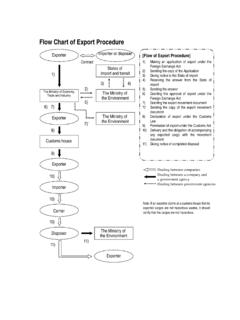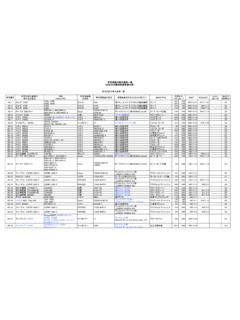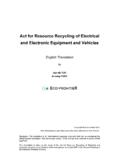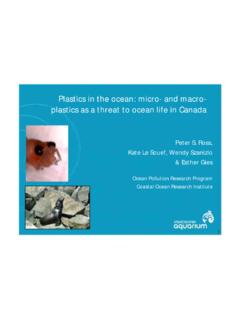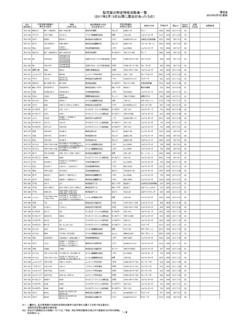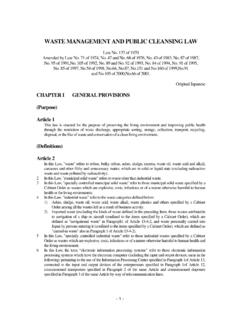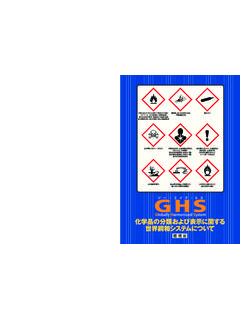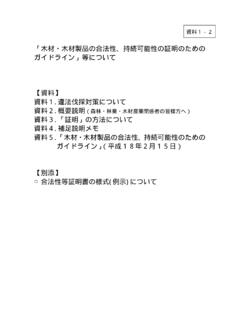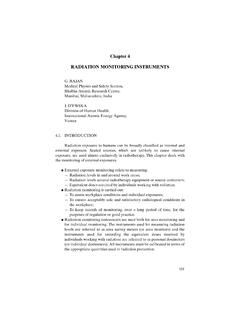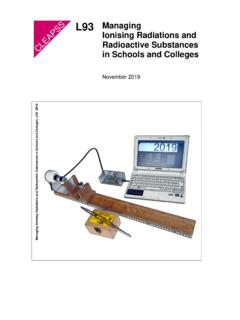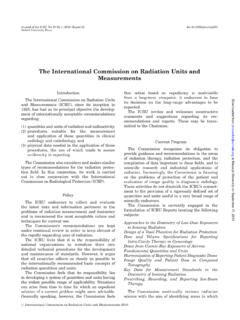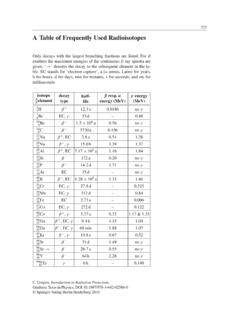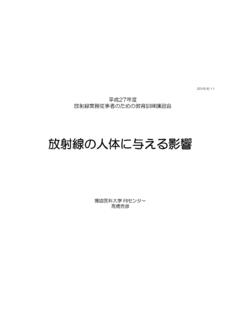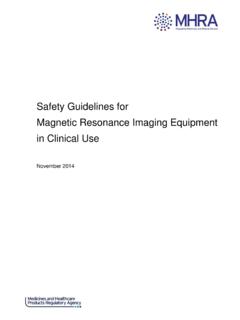Transcription of Units of Radiation Becquerel and Sievert
1 3434" Becquerel " and " Sievert " are the most common Units of Radiation . Becquerel is a unit of radioactivity and focuses on where Radiation comes from. It is used to express the amount of radioactive materials contained in soil, foods, tap water, etc. The higher the value expressed in becquerels, the larger the Radiation being emitted. Sievert is a unit of Radiation exposure dose that a person receives and is used with regard to what is exposed to Radiation , the human body. The larger the value expressed in sieverts, the larger the effects of Radiation to which the human body is exposed ( of Vol. 1, "Concepts of Doses: Physical Quantities, protection Quantities and Operational Quantities").The extent of Radiation effects on the human body varies according to the types of exposure, , internal or external exposure, or whole-body or local exposure (for details, refer to Vol. 1, " Exposure Routes"), and according to the types of Radiation (for details, refer to Vol.)
2 1, " Radiation "). By using sieverts to express all types of exposure, it is possible to compare their effects on human exposure of 1 mSv and internal exposure of 1 mSv are deemed to have equal effects on the human body. Exposure to 1 mSv of Radiation from outside the body and exposure to 1 mSv of Radiation from within the body mean exposure to a total of 2 mSv of in this reference material on March 31, 2013 Updated on March 31, of of Radiation35 The unit " Sievert " is named after Rolf Sievert , a Swedish researcher on radiological protection . He served as the chairman of the international X-ray and Radium protection Committee (IXRPC), the predecessor of the international commission on radiological protection (ICRP), and participated in founding the ICRP*1. Millisieverts (one millisievert = a thousandth of Sievert ) and microsieverts (one microsievert = a millionth of Sievert ) are mostly used to express Radiation doses that people receive in their daily ( unit of radioactivity), curie (former unit of radioactivity) and gray ( unit of absorbed dose) are all named after researchers who made significant contributions to the study of Radiation .
3 *1: It is said that George Kaye at the National Physical Laboratory played a central role in founding the ICRP. (Source: ICRP Publication 109, The History of ICRP and the Evolution of its Policies, ICRP, 2009)Included in this reference material on March 31, 2013 Updated on March 31, 20153636 Units of Radiation can be broadly divided into Units for sources of Radiation and Units for the receiving side. Becquerel , a unit of radioactivity, is used for sources of Radiation . Units for the receiving side are gray and Radiation passes through something, its energy is absorbed there. Gray is a unit for indicating the absorbed extent of effects on the human body varies depending on the types and energy quantities of Radiation even if the absorbed doses are the same. Doses weighting health effects of respective types of Radiation are equivalent doses (expressed in sieverts). The effective dose (expressed in sieverts) was developed for exposure management in radiological protection .
4 In contrast to the equivalent dose, the effective dose weights differences in sensitivity among organs and tissues and sums them up to express the Radiation effects on the whole in this reference material on March 31, 2013 Updated on March 31, of of Radiation37To calculate the effective dose that expresses the effects of Radiation exposure on the whole body, it is necessary to first determine the absorbed doses of individual tissues and organs exposed. The equivalent dose (expressed in sieverts) is obtained by multiplying the absorbed doses of individual tissues and organs by their respective Radiation weighting factors (WR) for taking into account the types of Radiation . The value of the Radiation weighting factor is larger for the types of Radiation having larger effects on the human body ( -particles: 20; -particles and -rays: 1).Once the equivalent doses for individual tissues and organs exposed to Radiation are determined, they are then multiplied by the respective tissue weighting factors (WT) for taking into account differences in sensitivity among organs, and the products are summed.
5 The tissue weighting factors are for weighting the Radiation sensitivity of individual tissues and organs. Any organ or tissue where Radiation is likely to induce fatal cancer is given a higher tissue weighting factors summate to 1. Thus, the effective dose can be considered as the weighted average of the equivalent doses of all organs and tissues. Effective doses can be calculated similarly for both internal and external exposures.(Related to of Vol. 1, "Various Factors")Included in this reference material on March 31, 2013 Updated on March 31, 20193838 Recommendations issued by the international commission on radiological protection (ICRP) in 2007 presented new Radiation weighting factors and tissue weighting factors. It is stated that -particles have 20 times larger effects on the human body than -rays and -particles with the same absorbed doses. Neutron beams are also given high Radiation weighting factors and are expected to have to 21 times larger effects on the human body than -rays and -particles depending on the energy quantities ( of Vol.)
6 1, "Conversion from Gray to Sievert ").A survey on the health effects of Radiation on atomic bomb survivors revealed which organs and tissues are more prone to the cancer-causing effects of Radiation ( of Vol. 1, "Tissues and Organs Highly Sensitive to Radiation "). These tissues are assigned high tissue weighting on the health effects of Radiation were also conducted on the children and grandchildren of atomic bomb survivors but no heritable effects of Radiation were observed ( of Vol. 1, "Chromosomal Aberrations among Children of Atomic Bomb Survivors"). Therefore, the ICRP lowered the tissue weighting factor for the gonads from in the 1990 Recommendations to in the 2007 Recommendations. In this way, the factors used in the calculation of effective doses are updated to accommodate new in this reference material on March 31, 2013 Updated on March 31, of of Radiation39 Methods for calculating an effective dose when the whole body is evenly exposed to 1 mGy of -ray irradiation and an effective dose when only the head is exposed to 1 mGy of -ray irradiation are the Radiation weighting factor (WR) for -rays is 1, the whole body being evenly exposed to 1 mGy means that the whole body is evenly exposed to 1 mSv (1 gray 1 (WR) = 1 millisievert).
7 That is, equivalent doses are 1 mSv for all organs and tissues. To calculate effective doses, the equivalent doses for individual tissues are multiplied by their respective tissue weighting factors and the products are summed. Bone marrow, colon, lungs, stomach and breasts are given a high factor of because these are organs with high risks of Radiation -induced fatal cancer. The skin of the whole body is assigned a factor of Thus, when the equivalent doses for all organs and tissues are multiplied by their respective tissue weighting factors and the products are summed, the result is an effective dose of 1 only the head is exposed to 1 mGy in Radiation inspection, the organs and tissues in the head, such as the thyroid, brain and salivary gland, are entirely exposed to Radiation , so equivalent doses are 1 mSv for all these organs and tissues. For organs and tissues that are only partly present in the head, such as bone marrow and skin, equivalent doses are obtained by multiplying by the ratios of their areas exposed to Radiation (bone marrow: 10%; skin: 15%).
8 When their equivalent doses are multiplied by their respective tissue weighting factors and the products are summed, the result is an effective dose of mSv.(Related to of Vol. 1, "Relationship between Units ")Included in this reference material on March 31, 2013 Updated on March 31, 20154040To control Radiation effects on the human body, it is necessary to take into account the effects of exposure on multiple parts of the body and the effects of previous exposures. The equivalent dose and the effective dose were invented for that equivalent dose is obtained by weighting effects on individual organs and tissues according to the types of effective dose is obtained by converting the effects on individual tissues to a value for the whole body. It is not the simple average of equivalent doses for individual organs but the result of weighting according to differences in sensitivity to Radiation among factor for weighting Radiation effects on individual organs is called the tissue weighting , protection quantities are calculated based on doses for organs and tissues in the human body.
9 They are therefore different from physical quantities such as the Radiation intensity ( unit : Becquerel ) and absorbed dose ( unit : gray) and cannot be measured directly with instruments. To indicate effects on the human body, operational quantities are survey meters use sieverts in their readings. They do not directly measure a protection quantity but show approximate values defined based on measured physical quantities, , operational quantities. Operational quantities include the ambient dose equivalent used in environment monitoring and the personal dose equivalent used in personal monitoring ( of Vol. 1, "Dose Equivalents: Measurable Operational Quantities for Deriving Effective Doses").To provide conservative (on the safe side) estimates of protection quantities, operational quantities are defined to assume slightly larger numerical values than the values of protection quantities in most in this reference material on March 31, 2013 Updated on March 31, of of Radiation41 Operational quantities for approximating effective doses that cannot be actually measured ( of Vol.)
10 1, "Concepts of Doses: Physical Quantities, protection Quantities and Operational Quantities") are defined, such as the ambient dose equivalent H*(d) (d is depth) for evaluating ambient doses in a work environment, etc., the personal dose equivalent Hp(d) for evaluating personal exposure, and the directional dose equivalent H' (d, ) ( is the angle of incidence) as a quantity for use when there is a need to evaluate the depth and directions of incidence as well, as in the case of exposure of the lens of the eye to -particles or soft , both the ambient dose equivalent and the personal dose equivalent are also called 1 cm dose equivalents because a depth of 1 cm is used in the case of exposure to , while the ambient dose equivalent is measured using measuring instruments that are less affected by directivity, such as a stationary ionization chamber and a survey meter, the personal dose equivalent is measured using a small personal dosimeter worn on the trunk of the body, so incidence from the back is evaluated while a self-shielding effect is always at work.
